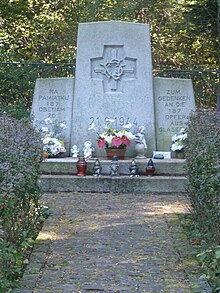Glaserhau massacre
In the massacre of Glaserhau (Slovakian Sklené , until 1927: Skleno) in the Hauerland on September 21, 1944 during the Slovak national uprising after the occupation of the place by Slovak partisans, 187 male German-speaking residents of the place were shot. The partisans belonged to the 3rd Company of the 8th Division of the 1st Czechoslovak Partisan Brigade , they had moved into Glaserhau on September 20 and acted on the verbal orders of the commander of the Soviet instruction officer Leonid Nikolayevich Slavkin (* 1916 in Vladivostok ; † 1971 in Zaporizhia , today's Ukraine).
course
On the orders of the Slovak partisans, all of the town's German men between the ages of 16 and 60 had to come to the village square early in the morning with shovels and supposedly for work. The group was then taken to the train station and loaded into several railroad cars. They were taken by train to a branch track in front of the "Plains Forest" about two kilometers outside the village. About 25 men were the first to be pulled out and had to dig a pit in the nearby forest: 8 m long, 1.50 m wide and almost 60 cm deep. Then they had to stand tightly packed in the pit and were killed with machine guns.
Most of the other men were then shot and only a few managed to escape into the forest. The shot dead remained in the open for several days and were buried by their relatives in a mass grave on the edge of the forest after the partisans had withdrawn .
Survivors
The shooting began with the occupants of the last car. Thanks to the efforts of the teacher Josef Stricz, who risked his life, it was possible to take the 63 men in the first car away to Slovenská Ľupča (Windisch Liptsch) in good time and thus save them from being shot. Their families thought they were dead until they returned to Glaserhau some time later.
Pastor Msgr. Josef Pöss was one of the survivors and thus witnesses of the massacre . Immediately after the fire opened, he pretended to be dead and survived between and among the dead with only moderate gunshot wounds. He survived the expulsion and later became dean in Württemberg.
The Glaserhau massacre would probably have claimed far more victims if most of the local Germans had not traditionally worked as seasonal workers in Austria from spring to autumn. Glaserhau had around 4,500 inhabitants at that time, around 2,600 of whom were Germans.
Similar operations
The Glaserhau massacre is the largest known of several similar crimes against Carpathian Germans between the end of August and the end of September 1944. Similar massacres also took place in Veľké Pole / Hochwies and Paulisch (together 85 dead), Ružomberok / Rosenberg im Waagtal (August 27, 1944, 146 deaths), Banská Štiavnica / Schemnitz, Banská Bystrica / Neusohl, Handlová / Krickerhau (more than 80 deaths), Nitrianske Pravno (then Nemecké Pravno; German: German samples; 30 deaths), in the Sklabina camp (130 deaths), in Deutsch-Lipsch (32 dead), Kunschhau (69 dead) and other places. In total, well over 600 people died. They mark the beginning of the Carpathian Germans' escape from Slovakia.
Work-up
After the establishment of the Second Slovak Republic , Slovak civil rights activists, especially Josef Stricz , tried to come to terms with the mass murder . A memorial has been located at the site of the massacre since 1994. In the archive of the Museum of the Slovak National Uprising in Banská Bystrica (Neusohl) there were recorded statements by six murderers about their activities and their operations during the entire period of the uprising. At the end of the 1990s, police investigations began, but were discontinued without a trial, as the person in charge, Leonid N. Slawkin, who was found to be responsible, had died in 1971.
See also
- Camp Nováky in Hauerland (Central Slovakia)
- Camp Deutschendorf (Poprad) in Spiš (Eastern Slovakia)
- Camp Engerau (Petržalka) in western Slovakia
literature
- Federal Ministry for Expellees, Refugees and War Victims Ed. & Theodor Schieder (edit.): Documentation on the expulsion of Germans from East-Central Europe . Vol. 4, 1–2: The expulsion of the German population from Czechoslovakia . Bonn 1957.
- Johann Grossmann, Johann Daubner: Glaserhau. A German village in the Hauerland. 2., revised. Edition Schwäbisch Gmünd 1986.
- New Year Stric: Josef Stricz the fighter for Glaserhau. Reminder to my father. With numerous illustrations and facsimiles, publisher: Slovenske Narodne Museum, 2003.
Individual evidence
- ↑ Federal Ministry for Expellees, Refugees and War Victims, Ed .: The Expulsion of the German Population from Czechoslovakia . Volume 4 of the documentation on the expulsion of Germans from East Central Europe , see Lit. Zu Glaserhau Vol. 1: S. 163, Vol. 2: S. 713f, 717f, 744, 767, 771, 773, 784. Bonn 1957 ISBN 3 -89350-560-1 .
- ↑ Karpatenblatt No. 9/2004, p. 9.
- ↑ Karpatenblatt No. 9/2004, p. 9.
- ↑ Karpatenblatt No. 9/2004, p. 9.
- ↑ Numerous further references to this work enforced by Theodor Oberländer , preparatory work by Fritz Valjavec , in the lemma of the ministry, note - last edition 1994.
